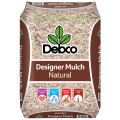

How to grow & care for Nasturtium
Nasturtiums are an easy to grow, flowering companion plant that’s also edible. Nasturtium flowers have a peppery flavour, add them to salads for a splash of colour and spicy kick. The leaves of nasturtium have a similar but milder peppery flavour and they can be used raw or cooked. You can even use them as mini gluten-free wraps! The green seed pods of nasturtiums are also edible - you might know them as “the poor man's caper” because once pickled they have a similar flavour to capers and caper berries.
Many nasturtiums have a sprawling growth habit and can be left to spread out along the ground, cascade over the sides of pots or even climb up a trellis. If you’re limited with space, look for the compact growing varieties that don’t sprawl - these have a more upright, rounded growth habit and look great in pots or tucked in between taller plants.
You’ll find nasturtiums with flowers in a range of colours including cream, yellow, orange, pink and red. Plant nasturtiums amongst your vegetable crops to attract beneficial insects and repel the pest insects.
Top 5 steps to growing nasturtiums
- Choose a full sun to part shade spot or grow in pots or hanging baskets.
- Nasturtiums will naturally self-seed and re-appear every year if they are happy in a spot.
- Give the plant a good cut back in mid summer if it’s becoming leggy and sparse - this will encourage a flush of new growth and flowers.
- Fertilise with Scotts Osmocote Pour+Feed for Flowering Plants if you need to encourage more flowers
- Nasturtiums are the perfect pretty and edible companion plant for your vegetable garden. Grow them amongst other edible crops or pop them into pots.
Shopping List
- Nasturtium seedlings or seeds
- Scotts Osmocote Pour+Feed for Flowering Plants
- Scotts Osmocote Compost Premium Soil Improver
- Garden trowel
- Mulch
- Defender Snail & Slug Pellets
- If growing in pots, you’ll need Scotts Osmocote Premium Potting Mix + Scotts Osmocote Pour+Feed for Flowering Plants and a suitable pot or container
Preparation & Planting in the garden
Nasturtiums are tough and hardy plants once established and they’ll tolerate a range of soils, but they’ll appreciate some added compost before planting. So prepare the site for planting by mixing a little Scotts Osmocote Compost Premium Soil Improver through the original soil - using a garden shovel to turn it through the top 10cm.
Gently remove the nasturtium seedling or plant from the nursery punnet or pot and tease the roots lightly if they are compact.
Plant your nasturtium into the prepared soil and back fill around each. Always follow the labels direction for spacing nasturtium plants or seedlings as some spread out more than others.
Water in well and mulch to suppress weeds and retain moisture.
Growing from seed
Nasturtium seeds are large and they germinate easily. Directly plant them where you’d like them to grow twice as deep as the seed is wide. Water them well at sowing and keep them moist during germination - within 7-10 days the seedlings will emerge and you can reduce watering.
Mulch around new seedlings to suppress weeds and retain moisture. If needed protect young seedlings from snails and slugs with a sprinkle of Defender Snail & Slug pellets around each plant.
Planting in pots
Nasturtiums can be grown any size pot with good drainage - choose a pot to suit the mature height and width of your chosen variety. If you’re limited on space look for the compact nasturtium varieties with a less sprawling growth habit.
Fill your pot or planter with Scotts Osmocote Premium Potting Mix. Gently remove the nasturtium from the nursery pot and tease the roots lightly if they are compact or separate the plants if they are growing in punnets. Plant the nasturtiums into the potting mix and backfill around each plant. Water in well and top the soil with mulch to retain moisture.
Fertilising & Care
Nasturtiums need very little fertiliser to grow and flower happily. If however you notice no flowers and lots of leaves, an application of Scotts Osmocote Pour+Feed for Flowering Plants fortnightly during the growing season will help promote more blooms.
Deadheading regularly is not needed but sprawling nasturtiums are prone to becoming leggy and messy looking by mid summer. If this happens give the plant a good cut back to reduce its growth by at least half. It will bounce back with new foliage and flowers in no time!
Nasturtiums are frost sensitive, so the first autumn or winter frost will see the plants die off completely. Save the seeds at this point if you’d like to replant them the following spring.
Pests & Diseases
Slugs and Snails can cause significant damage to young nasturtium seedlings. Protect young plants by setting beer traps (saucers filled with beer) amongst seedlings or use Defender Snail & Slug Pellets.
Caterpillars can from time to time infest nasturtium plants - they’ll eat the leaves and flowers. Remove and squash caterpillars as you find them or if needed use a spray like Defender Pyrethrum Insect Spray to control them.
Many gardeners will even use nasturtiums as decoy or sacrificial plants because the White Cabbage Butterfly will lay its eggs on nasturtium leaves and leave brassicas alone!



